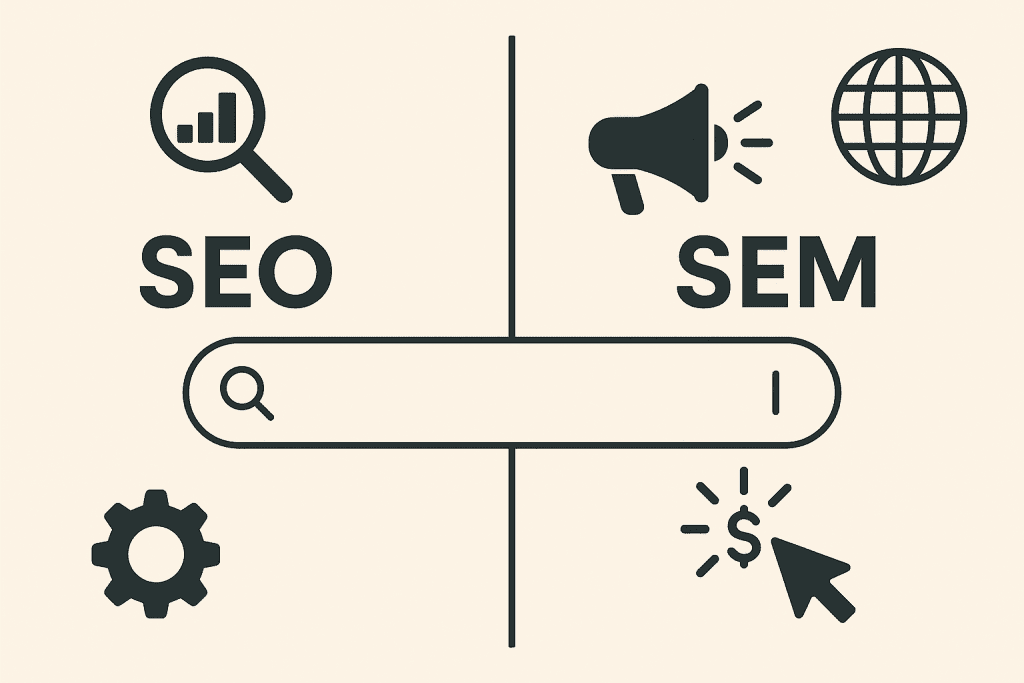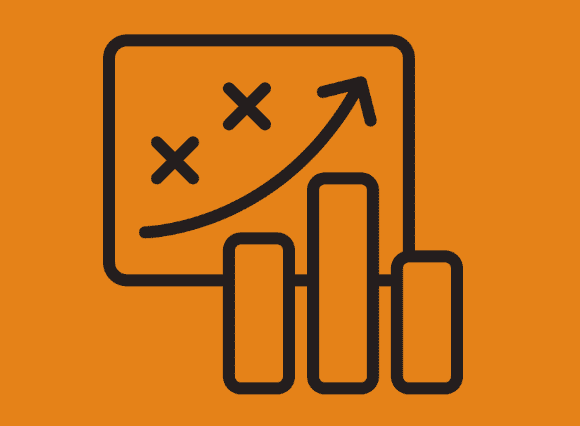Table of Contents
In today’s digital landscape, Search Engine Optimization (SEO) focuses on attracting unpaid, organic traffic by improving a website’s visibility in search engine results through content relevance, technical enhancements, and authority building, while Search Engine Marketing (SEM) encompasses both SEO and paid strategies—chiefly pay-per-click (PPC) advertising—to drive immediate visibility and traffic in search engines.

SEO is a long‑term investment that builds sustainable search presence but can take months to yield significant results, whereas SEM delivers faster, more controllable outcomes through paid placements, albeit at an ongoing cost per click.
A balanced digital strategy often combines SEO’s enduring foundation with SEM’s agility to maximize reach, optimize budgets, and enhance both short‑ and long‑term return on investment.
This pillar article will explore definitions, differences, advantages, metrics, tactical use cases, tools, emerging trends, and integration strategies to help marketers harness the full potential of both organic and paid search initiatives.
Introduction & Overview
What Is SEO?
Search Engine Optimization (SEO) is the practice of improving a website’s visibility in organic (unpaid) search engine results by optimizing on‑page content, technical infrastructure, and off‑page authority signals. Through keyword research, content creation, link building, and technical enhancements—such as improving page speed and mobile friendliness—SEO aims to align a site’s relevance with searcher intent, earning higher rankings over time.
What Is SEM?
Search Engine Marketing (SEM) refers to using paid advertising and other tactics on search engines to increase a site’s visibility in both paid and organic listings. While SEM is often used interchangeably with pay‑per‑click (PPC) advertising, it technically encompasses SEO as part of a broader strategy to capture search traffic through paid ads, such as Google Ads, and through organic results.
Basically, SEM is an umbrella term for SEO and SEA (Search Engine Advertising).
SEO vs. SEM: Core Concepts
What’s the difference between SEO vs. SEM? The easiest way to compare them would be SEO is a free way to get traffic, while SEM a paid way to get traffic.
- Organic vs. Paid: SEO drives traffic organically through unpaid listings, whereas SEM includes buying placements in search results via PPC auctions.
- Timeline: SEO’s impact typically builds gradually, usually taking 4–12 months to see substantial improvements, while SEM can generate immediate traffic as soon as campaigns go live.
- Cost Structure: SEO requires investment in tools, content creation, and possibly agency fees but has no direct cost per click; SEM incurs costs each time a user clicks an ad, making budget management critical.
Key Differences Between SEO and SEM
| SEO | SEM | |
|---|---|---|
| Definition | The practice of optimizing a website to rank higher in organic (unpaid) search results. | The use of paid advertising, including PPC (Pay-Per-Click), to drive traffic from search engines. |
| Traffic Source | Organic search results, relying on content, backlinks, and technical optimizations. | Paid search results through ad placements (e.g., Google Ads). |
| Cost | No direct cost per click; involves upfront investment in content, tools, and optimization. | Cost per click (CPC) for each ad, requiring an ongoing budget to maintain visibility. |
| Timeline | Long-term strategy, with noticeable results taking months (4–12 months). | Immediate results once campaigns are live. |
| Control over Targeting | Limited control; SEO depends on algorithms, backlinks, and content quality. | High control; SEM allows for detailed audience segmentation (demographics, device, location, etc.). |
| Sustainability | Results compound over time; evergreen content continues to drive traffic. | Results stop once the ad budget is paused or depleted. |
| Visibility | Organic listings take up space on search engine results pages (SERPs) for free. | Ads appear at the top or bottom of SERPs, often labeled as “Ad.” |
| Metrics/ KPIs | Organic CTR, Keyword rankings, Traffic growth, Conversions (leads/sales). | Impressions, Click-through rate (CTR), CPC, Cost per acquisition (CPA), Return on ad spend (ROAS). |
| Target Audience | Focuses on users at various stages of the buyer’s journey, especially informational and navigational queries. | Focuses on users with high intent, particularly those ready to make a purchase or take an action. |
| Flexibility & Speed | Less flexibility, as changes in SEO take time to reflect. | Highly flexible, with real-time adjustments to bidding, targeting, and ad creatives. |
| Long-Term Value | High, as organic content can provide long-lasting results. | Short-term, unless the campaign is sustained. |
| Risk | Algorithm updates can cause ranking fluctuations; competitive niches may require heavy investment. | Rising CPCs, ad fatigue, and ongoing costs can affect profitability. |
| Best For | Building brand authority, generating long-term organic traffic, and optimizing for search intent. | Immediate lead generation, seasonal promotions, and testing new products or offers. |
Long‑Term Growth vs. Immediate Results
SEO delivers compounding benefits: content and backlinks built today can continue to drive traffic and leads for years, often without additional spend. In contrast, SEM yields quicker visibility—ads can appear atop search results within minutes of campaign launch—but traffic stops the moment budget is paused.
Traffic Sources: Organic vs. Paid
Organic traffic originates from non‑paid listings and relies on ranking positions, click‑through rates, and algorithmic factors. Paid traffic comes from ad placements targeted by keywords, location, device, and audience demographics, providing precise control over who sees the ads and when.
Cost Comparison: Time Investment vs. Ad Spend
SEO’s “cost” is front‑loaded in time and resources—keyword research, technical audits, and content production—while ongoing costs diminish as the site gains authority. SEM’s cost is directly tied to ad spend, which can scale up or down but must be continually funded to maintain visibility.
Pros and Cons
Advantages of SEO: Why Organic Still Matters

- Credibility and Trust: High organic rankings signal authority and quality to users, often yielding higher click‑through rates (CTRs) than paid ads.
- Cost‑Effectiveness: Once established, organic listings generate traffic without paying per click, improving overall marketing ROI.
- Sustainability: Evergreen content continues to attract visitors over time, with periodic updates to maintain relevance.
When SEM Makes More Sense: Benefits of Paid Search
- Speed and Flexibility: SEM campaigns can launch immediately, scaling up quickly to capture timely opportunities, such as seasonal promotions or product launches.
- Precise Targeting: Audience segmentation by demographics, device, location, and intent ensures ads reach the most relevant prospects.
- Data‑Driven Optimization: Real‑time performance data on impressions, clicks, conversions, and return on ad spend (ROAS) allows rapid campaign adjustments.
Drawbacks and Limitations of Each Strategy
- SEO Limitations: Algorithm updates can cause ranking volatility; competitive niches may require heavy upfront investment; results can be slow to materialize.
- SEM Limitations: Ongoing ad spend can be costly; ad fatigue and rising CPCs in competitive markets can erode profitability; paid placements may suffer lower CTRs if perceived as ads.
Performance Metrics
Measuring performance is essential to understanding the effectiveness of your SEO and SEM efforts.
While both strategies aim to drive visibility, traffic, and conversions, they rely on different key performance indicators (KPIs) to evaluate success. SEO metrics focus on long-term growth and organic presence, analyzing how well content ranks, attracts clicks, and converts without direct ad spend.
In contrast, SEM metrics emphasize short-term performance, budget efficiency, and audience targeting through paid placements. By tracking the right KPIs for each channel, marketers can make data-driven decisions, allocate resources effectively, and refine campaigns to achieve better outcomes across both organic and paid search.
How to Measure Success: SEO KPIs
- Organic Visibility: Share of voice in SERPs across target keywords.
- Keyword Rankings: Position tracking for high‑value terms over time.
- Organic CTR: Percentage of users clicking a listing after seeing it in search results.
- Conversions: Leads or sales generated from organic traffic, reflecting SEO’s impact on business goals.
SEM KPIs and Analytics
- Impressions and Clicks: Volume metrics indicating reach and engagement.
- Click‑Through Rate (CTR): Percentage of ad views that result in clicks, a key indicator of ad relevance.
- Cost Per Click (CPC) and Cost Per Acquisition (CPA): Financial indicators measuring efficiency of spend and cost to acquire a customer.
- Return on Ad Spend (ROAS): Revenue generated per dollar of ad spend, critical for budget allocation decisions.
Strategy and Use Cases
Choosing between SEO and SEM—or determining how to use both in tandem—requires a clear understanding of your business goals, timeline, and available resources.
Each strategy has its strengths depending on the context: SEO lays the groundwork for sustainable, long-term growth, while SEM offers speed, precision, and agility. By aligning search tactics with specific business needs—whether it’s launching a new product, scaling brand awareness, or optimizing cost-per-lead—marketers can deploy SEO and SEM where they’ll have the greatest impact.
When integrated strategically, these approaches complement each other, creating a unified search presence that maximizes visibility, drives qualified traffic, and delivers consistent results across every stage of the marketing funnel.
When to Use SEO, When to Use SEM
- SEO Priority: For foundational content marketing, brand authority building, and attracting evergreen traffic.
- SEM Priority: For immediate lead generation, targeted promotions, and testing new offerings where speed is essential.
Combining SEO and SEM for Maximum Impact
Integrating SEO and SEM data—such as using high‑performing paid keywords to inform organic content strategy, and leveraging organic top performers to refine ad targeting—yields synergistic benefits, improving overall search presence and reducing wasted spend.
SEO and SEM in Different Business Stages
- Startups: Lean on SEM to generate early traction, validate product‑market fit, and gather quick data for iteration.
- Established Brands: Invest in SEO for long-term growth and cost optimization, while maintaining strategic SEM campaigns for market share defense and seasonal spikes.
Tools & Techniques
Understanding the tools and techniques behind SEO and SEM is essential for executing an effective search marketing strategy. While both disciplines focus on increasing visibility in search engines, the way they approach targeting, budgeting, content creation, and performance optimization differs significantly. In this section, we’ll explore the core tools used in SEO and SEM, how keyword targeting strategies diverge, and the tactical decisions that drive campaign success.
Tools of the Trade: Software for SEO and SEM
SEO and SEM each require a different toolbox to perform audits, analyze data, and manage campaigns effectively. SEO tools focus on long-term optimization, content strategy, and technical performance, while SEM tools are designed for ad creation, bid management, and real-time performance tracking. Choosing the right software stack can improve efficiency, enhance decision-making, and provide competitive insights.
- SEO Tools: SEMrush, Ahrefs, Moz, Google Search Console for keyword research, site audits, and backlink analysis.
- SEM Tools: Google Ads Editor, Microsoft Advertising, SpyFu, WordStream for campaign management, keyword segmentation, and bid optimization.
Keyword Targeting Differences
While SEO and SEM both revolve around keywords, their targeting strategies differ based on user intent, funnel stage, and campaign goals. SEO tends to focus on building authority across a range of search intents—especially informational and navigational—while SEM prioritizes high-conversion, transactional keywords to drive immediate results. Understanding these nuances is crucial for targeting the right audience at the right moment.
- SEO Keyword Research: Focuses on long‑tail, informational queries to capture users throughout the funnel.
- SEM Keyword Selection: Emphasizes high‑intent, transactional terms with clear bidding strategies and budget allocation per ad group.
Content, Bidding, and Budgets: Tactical Considerations
Beyond keyword targeting, SEO and SEM diverge in how content is created and optimized, how budgets are managed, and how performance is adjusted over time. SEO emphasizes content quality and search intent alignment, while SEM relies heavily on bidding strategies, ad creative testing, and real-time adjustments. Understanding these tactical elements helps marketers make more informed decisions about execution and resource allocation.
- SEO Content: Deep, E‑E‑A‑T–aligned articles and resources optimized for clusters of related questions to satisfy both user intent and emerging AI‑driven answer engines.
- SEM Bidding: Automated strategies like Target ROAS and Enhanced CPC leverage machine learning to adjust bids in real time for optimal performance.
Industry Trends & Insights
Evolving Search Algorithms and Impact on SEO
Search engines are increasingly integrating generative AI, reshaping how content is surfaced and valued. Marketers now optimize for both traditional rankings and AI response quality—captured under new disciplines like Answer Engine Optimization (AEO).
The Future of Paid Search: Automation, AI, and Privacy
AI‑enabled automation continues to transform SEM workflows, from predictive keyword suggestions to dynamic ad creatives and bid management. Privacy‑first measures, including cookieless targeting and first‑party data strategies, are becoming essential.
How SEO and SEM Are Converging
With AI chatbots and large language models handling an increasing share of queries—and often not passing clicks to websites—brands must optimize for both link clicks and brand mentions in AI‑generated answers, blending SEO, SEM, and AEO tactics to maintain visibility across all search interfaces.
Conclusion & Recommendations
Which Strategy Is Right for Your Business?
Assess your goals, timeline, and budget to allocate resources effectively: prioritize SEO for long‑term authority and cost efficiency, SEM for rapid visibility and targeted campaigns, and an integrated approach to leverage data synergies.
Final Thoughts: Integrating SEO and SEM for a Balanced Digital Strategy
A holistic search strategy combines the enduring benefits of organic optimization with the agility of paid search. By continuously monitoring performance metrics, adopting emerging AI tools, and aligning SEO and SEM teams, marketers can achieve sustainable growth and adaptability in an evolving search ecosystem.
Hi, I’m Adam — a Denver-based SEO and content strategist with over 10 years of experience helping websites climb the search rankings and increase conversions. Whether it’s a site audit, keyword strategy, or a full-blown content overhaul, I bring a creative, technical, and human approach to digital marketing.

